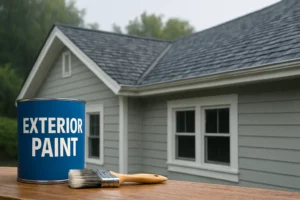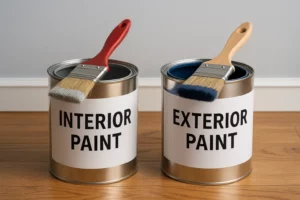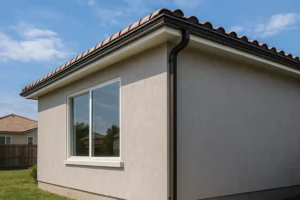So you finally scheduled that long-overdue paint job for your home’s exterior. The team shows up, brushes and rollers in hand, ready to give your house a fresh look. But then you glance at the weather forecast—rain is coming. Now you’re wondering:
How long for exterior paint to dry before rain can ruin everything?
At Ground Up Construction, we get this question all the time from homeowners across San Diego. Painting your home’s exterior is a big investment, and you want to make sure it lasts. That means understanding how weather—especially rain—affects paint drying times.
In this blog, we’ll break down:
- How long exterior paint needs to dry before it’s safe from rain
- What factors can speed up or slow down drying
- What to do if rain sneaks in too soon
- And how to plan a paint job that stands the test of time
Let’s get into it.
Why Does Drying Time Matter So Much?
When you paint your home’s exterior, you’re not just adding color—you’re protecting your home from sun, rain, wind, and moisture. If paint doesn’t have enough time to dry and cure properly, rain can cause:
- Streaks and runs
- Uneven color
- Blistering or bubbling
- Peeling down the road
That’s why timing matters. The last thing you want is to invest in a fresh coat of paint, only for it to wash away with the next storm.
How Long for Exterior Paint to Dry Before Rain?
Most outside paints need some time to get hard and not get ruined by water. Here’s the deal:
- Latex (Water-Based) Paints: These dry pretty fast. If it’s not too humid and not too cold, they usually need about 4 to 6 hours before a little rain won’t hurt them.
- Oil-Based Paints: These take much longer to dry, like 12 to 24 hours. They need all that time to become strong. If they get wet too early, they can also get messed up.
Why Good Weather Helps Paint Dry
Think of paint drying like water evaporating. It needs the right conditions:
- Not Too Cold or Too Hot (Around 70°F or 21°C): Warm air helps paint dry faster, but super hot air can make the top dry too fast, and the inside will stay wet.
- Not Too Wet (Humidity Below 50%): If the air is full of water (high humidity), the water in latex paint can’t go anywhere, so it takes longer to dry. Same for the stuff in oil-based paint.
- Not Too Windy: Strong wind can blow dust and even rain onto your wet paint, making it look bad. It can also make it dry unevenly.
Think About the Weather
What Affects Drying Time?
Humidity
Temperature
Exterior paint dries best between 50°F and 85°F. Too cold, and the paint won’t cure properly. Too hot, and it can dry too fast on the surface, trapping moisture underneath.
Wind
Sunlight
What Happens If It Rains Too Soon?
If rain hits before your exterior paint has had enough time to dry, you could see:
- Streaks and drip marks
- Spotty or patchy areas
- Paint washing off entirely in extreme cases
If it’s just a light sprinkle after 4–6 hours of drying, you might get lucky and avoid damage. But if heavy rain hits within 2–3 hours, expect to see issues.
If this happens, don’t panic. Let the surface dry completely, then assess the damage. You may need to touch up affected areas or re-coat the surface.
Need help? Our exterior paint and stucco services team can inspect the damage and recommend the best fix.
How to Plan a Paint Job Around Rain
Here’s how we approach it at Ground Up Construction:
🗸 Check the weather—twice. We look for at least 24 hours of dry weather before and after painting.
🗸 Start early. Morning is the best time to begin exterior painting, giving the paint a full day to dry before cooler, damper evenings.
🗸 Use the right paint. Some exterior paints are formulated to resist moisture sooner. For example, certain products can withstand rain as soon as 1–2 hours after application.
🗸 Don’t cut corners. Even if the forecast looks clear, we stick to best practices:
- Proper prep
- Primer where needed
- Two coats of paint
- Drying time between coats
🗸 Be flexible. If the weather changes unexpectedly, we pause the job. No sense in wasting materials or risking a bad result.
Can You Speed Up Drying Time?
Yes—but only a little. Here are a few tips:
- Paint in the morning, when temperatures are rising, and humidity is lower.
- Choose fast-drying exterior paint (ask us for recommendations).
- Use fans or blowers in enclosed spaces like porches or patios.
- Paint in thinner coats, allowing each layer to dry fully.
But remember—nothing replaces good weather. If rain is in the forecast, it’s usually better to wait.
How We Protect Your Paint Job at Ground Up Construction
At Ground Up Construction, we treat every exterior paint project like it’s our own home. That means:
- Careful scheduling – We don’t paint unless the weather is on our side.
- High-quality materials – We use exterior paints built for San Diego’s climate, including products that resist UV, moisture, and salt air.
- Expert prep – Power washing, scraping, priming—we do it right from the start.
- Clean job sites – No mess left behind.
- Clear communication – We’ll keep you updated on timing, progress, and weather delays.
Want to learn more about our process? Check out our exterior paint and stucco services page.
Questions About Your Painting Project? We’re Here to Help.
If you’re planning an exterior paint project and worried about rain, drying time, or the best products to use—give us a call. We’ll walk you through the timeline, recommend the right paint for your home, and help you get a finish that looks beautiful and lasts for years.
Contact Ground Up Construction today. Let’s make your home the best-looking one on the block—rain or shine.



